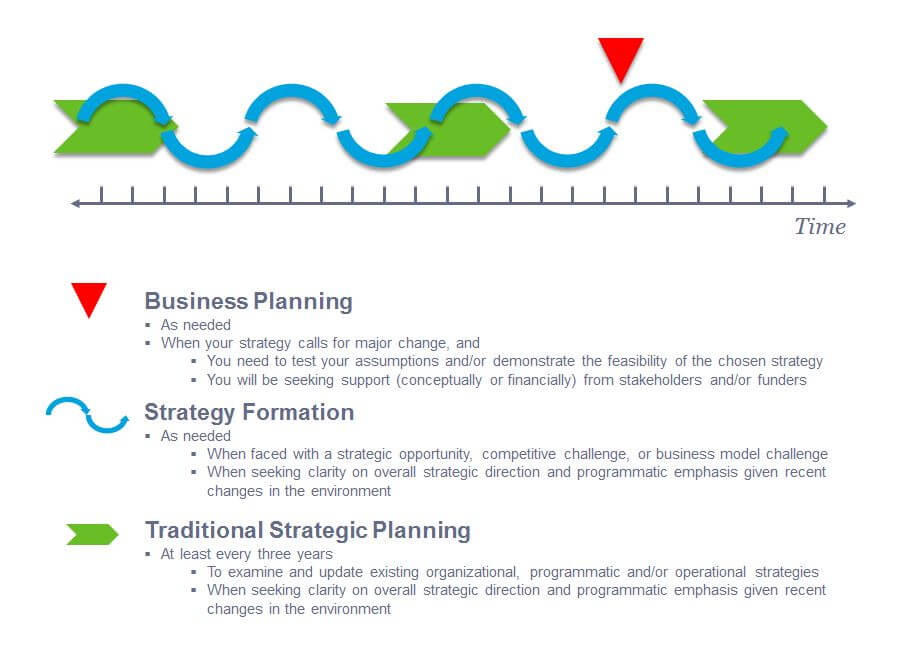Nonprofit Strategy and Business Planning: A Fresh Look
Two Different Tools for Nonprofit Effectiveness
As the drive toward more rigorous examination of investments in the nonprofit sector continues, more organizations are turning to business planning to prove their credibility to increasingly cautious funders. Many have proceeded by essentially adding a financial analysis section to their traditional strategic plan. However, this risks conflating two processes that in fact perform essentially different functions.
Strategic planning is, at its best, the process of considering and making strategic decisions. Business planning is the process of determining the parameters of an economically and operationally successful undertaking.
An organization may find itself faced with a strategic opportunity, competitive challenge, or business model challenge at any point in time. Business planning is most powerful when the strategy calls for some major change that must be tested. Before an organization can productively engage in business planning, it must have identified a strategy.
Strategies can come either from a traditional strategic planning process, or, as shown in the figure below, from a more targeted strategy formation process – part of what we call Real Time Strategic Planning. The strategy may be provisional – we will only proceed with this undertaking if the business planning process proves that it is an economically and operationally viable way to advance our mission – but board and staff must believe it promising enough to warrant investing time and money in a business planning process.

For example, a theatre may identify a new competitor – a performing arts center – that has opened its doors and is attracting a lot of attention and resources for its shows, leaving the theatre with empty seats. This competitive challenge requires a response, and that response is likely to be in the form of a strategy. Perhaps the theatre decides to approach the performing arts center and suggest a partnership focused on coordinated programming and joint marketing. Or perhaps it decides to cut ticket prices and add a greater variety of shows.
Either response fits the definition of a strategy: a coordinated set of actions designed to create and sustain a competitive advantage in achieving a nonprofit’s mission. But is the chosen path the right strategy for the theatre at this point in time?
The board and management team may be happy with the concept, and it may work to strengthen the theatre’s position as a fixture in the community. There will undoubtedly be economic considerations, however. What expenses will the theatre incur as it launches and implements this strategy? Long-term and without subsidy, will it be able to restore its previous level of ticket sales? What overlap exists between the two organizations’ subscribers and donors, and how is either the partnership or the pricing strategy likely to affect contributions? Will the chosen strategy attract new audiences to the theatre’s shows?
If the answers to these questions are obvious then the theatre can move forward with its strategy. However, if the theatre has weak financials, and if it is not sure how its constituents will respond or what is happening in the broader market around support for live performance (perhaps the community’s overall theatre attendance is in decline), it may need to take a closer look at its proposed strategy as an economic proposition.
Through business planning the theatre (perhaps in cooperation with the Performing Arts Center) could examine its market, operations, revenue and expense trends, and any anticipated capital investments (such as a new ticketing system that will allow the two theatres to integrate sales). It can test the strategy it has developed to see if it makes economic and operational sense. This is a fundamentally different process from strategy development that requires a different mindset and employs a different set of skills. The value of the plan is directly related to the rigor of the planning process.
Strategic planning is, at its best, the process of considering and making strategic decisions. Business planning is the process of determining the parameters of an economically and operationally successful undertaking.
To further distinguish between a strategic plan and a business plan it is important to distinguish between the process and the resulting product. A strategic plan or business plan – the product – is simply the results of those respective processes consolidated into a written document. When approaching either, take care to keep the process and the product separate in your mind, and not to rush toward production of a written plan at the expense of the process through which the decisions recorded in the document are made.
